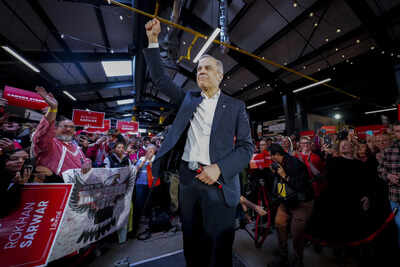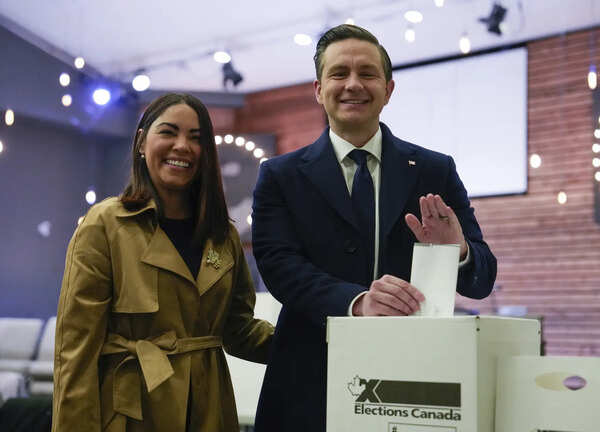
Liberal Leader Mark Carney makes a campaign stop in Saskatoon, Saskatchewan, Sunday, April 27, 2025. (Sean Kilpatrick/The Canadian Press via AP)
The 2025 Canadian federal election, held on April 28, delivered a political earthquake that few had predicted: the
Liberal Party
, led by
Mark Carney
, secured an improbable fourth consecutive term. While they fell short of a majority, winning approximately 168 seats in the expanded 343-seat House of Commons, it was a clear mandate against populism, external interference, and political instability.
The Conservatives finished second with around 143 seats, while the
Bloc Québécois
fell to about 23, and the
New Democratic Party
(NDP) was reduced to just 7 seats.
Voter turnout
surged, fuelled largely by concerns over Canadian sovereignty and an unusually intense focus on domestic unity in the face of global uncertainties.
Here are the biggest winners and losers from a contest that reshaped Canada's political direction:
Winners
1. Mark Carney
From central banker to national leader, Mark Carney’s transition into politics was initially seen as an elite rescue mission. Instead, he led the Liberals to a resilient victory, capitalising on nationalistic sentiments in response to US President Donald Trump's provocative remarks about Canada. Carney positioned himself as a calm, serious antidote to chaos — and voters rewarded him handsomely.
2. Chrystia Freeland
If Mark Carney was the face of the campaign, Chrystia Freeland was its architect. As Deputy Prime Minister and a master strategist, Freeland’s work behind the scenes ensured the smooth transition from the Trudeau era and safeguarded the Liberals' Atlantic and urban strongholds. Her influence inside the party has now reached its zenith, making her a future contender for the top job.
3. The Liberal Atlantic Machine
In Atlantic Canada, the Liberals reminded the country what old-school politics looks like. Ground game, loyal networks, and localised campaigning led to a near sweep in Nova Scotia, Newfoundland and Labrador, New Brunswick, and Prince Edward Island. It was a textbook lesson in political muscle memory.
4. Canadian Voter Turnout
The election marked one of the highest turnouts in recent decades. Canadians, usually reserved in their political engagement, turned out in record numbers — spurred by anxieties about foreign influence, economic stability, and national unity. Democracy, for once, was not just a ritual but a rally.
5. Urban Liberalism
If there was any doubt about the Liberals’ lock on Canada's major cities, it has now been obliterated. Toronto, Montreal, Vancouver — all continued to paint themselves Liberal red, deepening the urban-rural divide and offering the party a crucial firewall against Conservative advances elsewhere.
Losers

Conservative Leader Pierre Poilievre, right, and his wife Anaida Poilievre cast their votes in the federal election in Ottawa, Canada, Monday, April 28, 2025 in Ottawa. (Adrian Wyld/The Canadian Press via AP)
6. Pierre Poilievre
For Pierre Poilievre, it was a disaster. Touted as the Conservative saviour, he instead became its cautionary tale — failing not only to secure a majority but also losing his own seat. His brand of American-style populism, sharp rhetoric, and free-market absolutism alienated the very suburban voters Conservatives needed to win.
7. Jagmeet Singh
Jagmeet Singh’s once-bright star dimmed dramatically. Reduced to a mere 7 seats nationally, the NDP haemorrhaged support to the Liberals as progressive voters rallied to prevent a Conservative government. To make matters worse, Singh lost his own seat, prompting immediate questions about his future leadership.
8. Bloc Québécois
In a year when sovereignty was on everyone’s lips, the Bloc Québécois found themselves talking about the wrong kind. Voters in Quebec, worried more about federal stability than independence dreams, turned away. The Bloc’s seat count fell sharply, and the movement that once shook Ottawa seemed to lose its voice.
9. Khalistani Advocacy Groups
Historically, some Khalistani advocacy groups managed to exert a degree of influence among segments of the Indo-Canadian community, particularly during the turbulent decades of the 1980s and 1990s. With a keen focus on economic stability, multicultural integration, and strengthened bilateral relations with India, the electorate overwhelmingly chose mainstream political platforms over radical separatist agendas. Contemporary public sentiment, supported by robust law enforcement and legislative initiatives against violent extremism, has marginalized Khalistani-linked efforts—rendering them politically isolated and increasingly irrelevant in a Canadian political arena that now prizes unity and pragmatic governance.
10. Donald Trump
Donald Trump was not on the ballot, but his shadow loomed large. His brash comments about Canada being the "51st American state" and his aggressive tariff policies galvanised a nationalist backlash. Canadian voters rallied behind leaders who promised to preserve their sovereignty, effectively turning Trump into an unintentional campaign villain.

 6 hours ago
39
6 hours ago
39




























 English (US)
English (US)